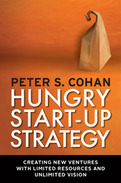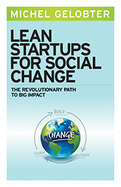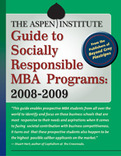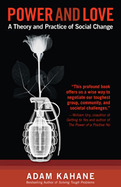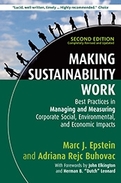2013
Entrepreneurs are hungry. But it's not just because they're living on ramen and adrenaline while they pour their all into their business. Peter Cohan has found it's something deeper: a hunger to create the kind of world they want to work in.
Entrepreneurs are hungry. But it’s not just because they’re living on ramen and adrenaline while they pour their all into their business. Peter Cohan has found it’s something deeper: a hunger to create the kind of world they want to work in. To leave a legacy, they build carefully with limited resources and maintain control of the venture’s direction. For years, students have told Cohan that the seminal business strategy guide, Michael Porter’s Competitive Strategy, was too big-company focused. So Cohan—who once worked with Porter—has written the first business strategy book to address start-ups’ very different challenges. Cohan focuses on six key start-up choices—setting goals, picking markets, raising capital, building teams, gaining market share, and adapting to change—explaining the unique rules start-ups must follow. For example, when setting goals, large corporations try to maximize their long-term return on equity, but resource-poor start-ups have to plan by setting a series of short-term goals—and how they do this will mean the difference between blazing a trail or flaming out. When entering a new market, well-fed companies can invest substantial time and capital before ever launching a product, but hungry start-ups must get an adequate prototype in front of customers fast, get feedback, and quickly develop a viable business model or they’ll starve to death. For each of these six areas, Cohan provides a decision-making approach and lively case studies of what actual entrepreneurs have done. He extracts hard-hitting lessons not only for start-ups but also for investors and even established companies. Hungry Start-up Strategy offers a full menu of vital information for anyone seeking to cook up a thriving business from scratch.- The first research-based book on business strategy for start-ups
- Based on Cohan's venture investment experience and on his interviews with over 150 start-up CEOs
- Offers specific approaches for six critical start-up decisions
- Click here for the press release
Entrepreneurs are hungry. But it's not just because they're living on ramen and adrenaline while they pour their all into their business. Peter Cohan has found it's something deeper: a hunger to create the kind of world they want to work in. To leave a legacy, they build carefully with limited resources and maintain control of the venture's direction.
For years, students have told Cohan that the seminal business strategy guide, Michael Porter's Competitive Strategy, was too big-company focused. So Cohan -- who once worked with Porterhas written the first business strategy book to address start-ups' very different challenges.
Cohan focuses on six key start-up choicessetting goals, picking markets, raising capital, building teams, gaining market share, and adapting to changeexplaining the unique rules start-ups must follow. For example, when setting goals, large corporations try to maximize their long-term return on equity, but resource-poor start-ups have to plan by setting a series of short-term goalsand how they do this will mean the difference between blazing a trail or flaming out. When entering a new market, well-fed companies can invest substantial time and capital before ever launching a product, but hungry start-ups must get an adequate prototype in front of customers fast, get feedback, and quickly develop a viable business model or they'll starve to death.
For each of these six areas, Cohan provides a decision-making approach and lively case studies of what actual entrepreneurs have done. He extracts hard-hitting lessons not only for start-ups but also for investors and even established companies. Hungry Start-up Strategy offers a full menu of vital information for anyone seeking to cook up a thriving business from scratch.
Traditionally, whether creating a new business or a new program, entrepreneurs in all sectors develop a plan, find money to fund it, and pursue it to its conclusion. The problem is, over time conditions can change drastically—but you're locked into your plan. The lean startup is all about agility and flexibility. Its mantra is “build, measure, learn”: create small experimental initiatives, quickly get real-world feedback on them, and use that data to expand what works and discard what doesn't.
Using dozens of social sector examples, Gelobter walks you through the process. The standard approach wastes time and money. The lean startup will help your organization vastly increase the good it does.
2010
-
A new approach, proven in the field, for making progress on our most important and difficult collective challenges
-
Based on Kahanes first-hand experiences working with teams of business, government and civil society leaders around the world
-
Profound, personal and practical
The two main ways that people try to solve their toughest group, community and societal problems are fundamentally flawed. They either push for what they want at all costsin its most extreme form this means waror try to completely avoid conflict, sweeping problems under the rug in the name of a superficial peace. But there is a better way: combining these two seemingly contradictory approaches.
Adam Kahane argues that each is a reflection of two distinct, fundamental drives: power, the single-minded desire to achieve ones solitary purpose; and love, the drive towards unity. They are inextricable parts of human nature, so to achieve lasting change you have to able to work fluidly with both. In fact, each needs the other. As Martin Luther King put it, Power without love is reckless and abusive, and love without power is sentimental and anemic.
Kahane delves deeply in the dual nature of power and love, exploring their complex and intricate interplay. With disarming honesty he relates how, through trial and error, he learned to balance between them, shifting from one to the other as though learning to walkat first falling, then stumbling forward, and finally moving purposefully toward true, lasting reconciliation and progress.
For the last twenty years Kahane has worked around the world on a variety of challenges: economic development, food security, health care, judicial reform, peace making, climate change. He has worked with diverse teams of leadersexecutives and politicians, generals and guerillas, civil servants and trade unionists, community activists and United Nations officials, clergy and artists. He has seen, up close and personal, examples of inspiring progress and terrifying regress. Power and Love reports what he has learned from these hard-won experiences.
Offers a complete guide to the details of implementing and measuring the impact of CSR initiatives
Most companies today have some commitment to corporate social responsibility, but implementing these initiatives can be particularly challenging. While a lot has been written on ethical and strategic factors, there is still a dearth of information on the practical nuts and bolts. And whereas with most other organizational initiatives the sole objective is improved financial performance, sustainability broadens the focus to include social and environmental performance, which is much more difficult to measure.Now updated throughout with new examples and new research, this is a complete guide to implementing and measuring the effectiveness of sustainability initiatives. It draws on Marc Epstein's and new coauthor Adriana Rejc Buhovac's solid academic foundation and extensive consulting work and includes best practices from dozens of companies in Europe, Asia, North America, South America, Australia, and Africa. This is the ultimate how-to guide for corporate leaders, strategists, academics, sustainability consultants, and anyone else with an interest in actually putting sustainability ideas into practice and making sure they accomplish their goals.
- A comprehensive guide to implementing and evaluating corporate sustainability initiatives
- Combines a thorough grounding in the latest research with the best practices of 100 organizations worldwide, including prominent companies such as Canon, Coca-Cola, Dell, FedEx, General Mills, Johnson & Johnson, Nestle, Starbucks, Warner Brothers
The best practices in corporate social responsibility (CSR) are no longer the exclusive domain of companies like Ben & Jerry's or the Body Shop; now even companies like GE and Wal-Mart are making significant financial and organizational commitments to social and environmental issues. But senior executives are realizing that implementing sustainability is particularly challenging. While a lot has been written on ethical and strategic factors, there is a dearth of information on the practical nuts and bolts of implementation and virtually nothing on how to measure the results.
In Making Sustainability Work, Marc Epstein builds on his influential and highly respected previous work to produce the ultimate how-to guide for corporate leaders, strategists, academics, sustainability consultants, and anyone else with an interest in actually putting sustainability ideas into practice.



